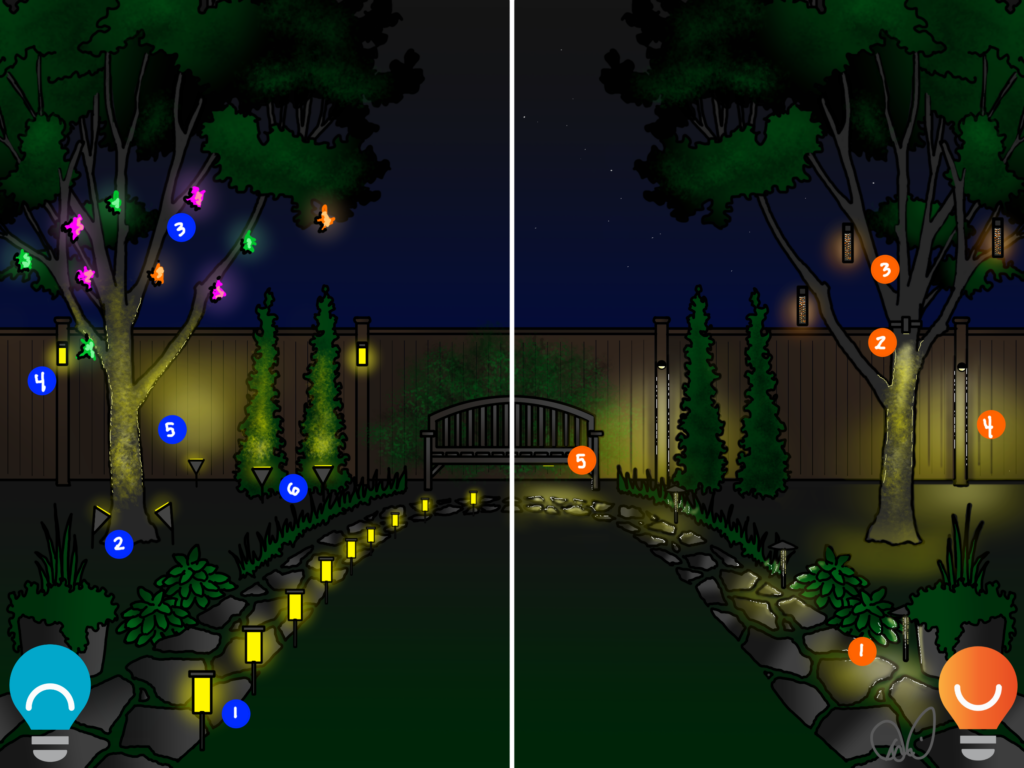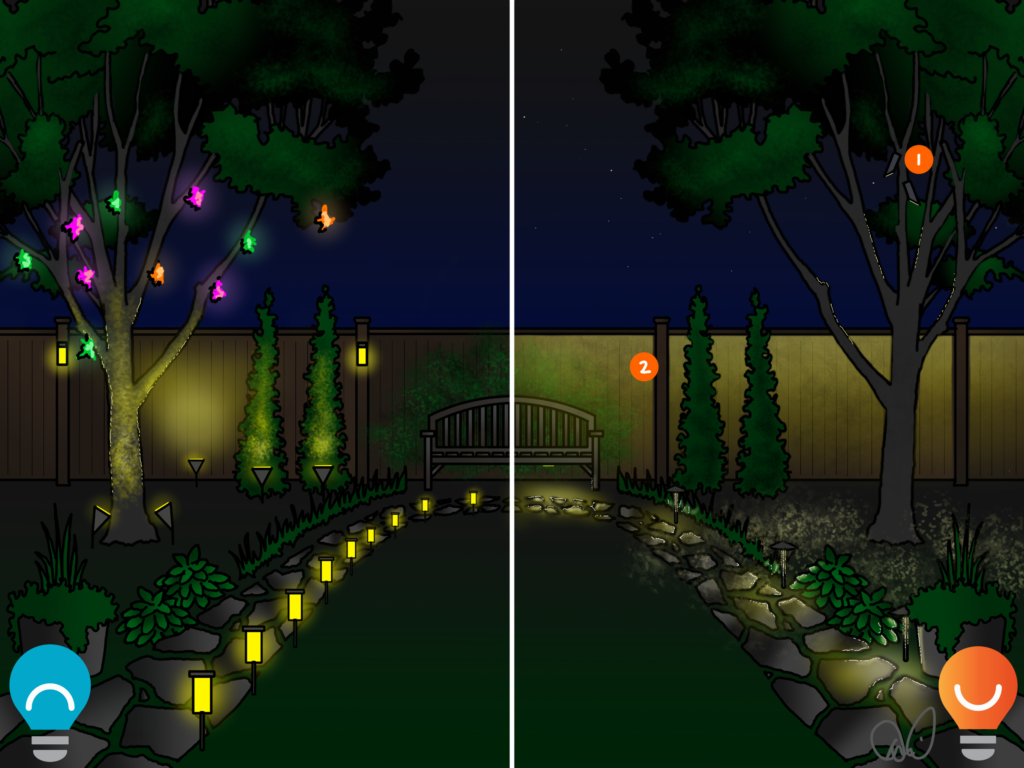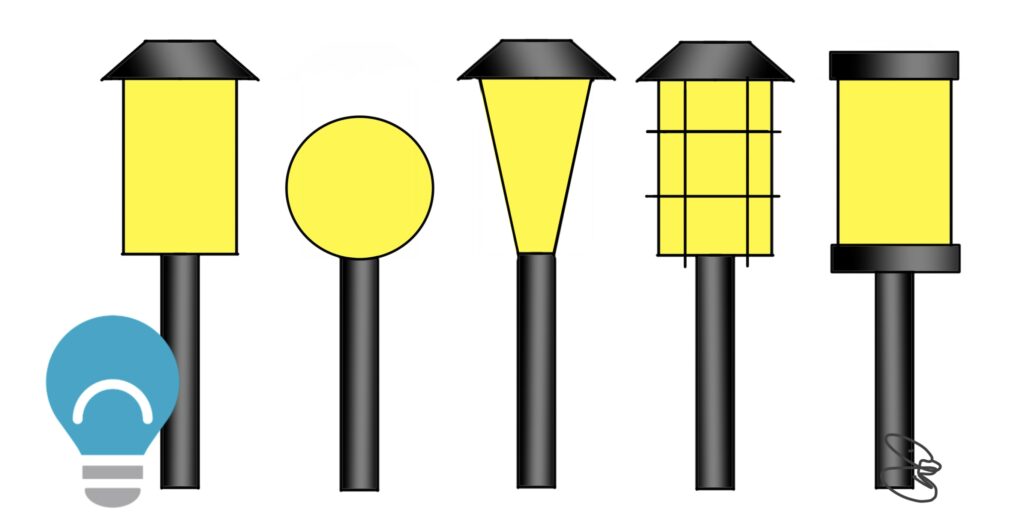July seems like the perfect month to write a blog post about landscape lighting in a back yard. Our days are long and our evenings warm in Wisconsin right now, and we enjoy relaxing outdoors as long as the mosquitoes will let us. A little well-planned light will extend our evenings a bit longer as the days grow slowly shorter towards the change of seasons. But what kind of light do we want outdoors?
The rules for outdoor lighting are quite different than for indoor illumination, where we want to simulate bright daylight during the day and dim sunset light at night. Outdoors, we get both of those for free, which allows us to be a little more creative and selective with our choices.
There are rules of thumb for better outdoor lighting none the less. First, like all natural outdoor environments, the most important goal is to use as little light as possible. Every photon we bring outdoors is a potential disruptor of what we love about nature. Too many stray photons and we risk making shooting stars harder to see or scaring the fireflies out of our yard. Poorly conceived outdoor lighting can disrupt the birds we love to hear or draw baby turtles away from the safety of water. Every bit of life from insect to tree is affected by light, and we must be careful if we want to enjoy the benefits of a healthy environment for centuries to come.
If rule one is to use as little as possible, rule two is to turn it off when not in use. I have been guilty of setting timers on my outdoor lighting to come on sunset and off at sunrise. But do I really need my front or back yard illuminated at three in the morning? In most cases, that is simply a waste of resources, mine and the planet’s.
Rule three is to point lights down and away from your eyes. No one likes the kid in the campground who shines their flashlight in your face, but at home we regularly choose lighting fixtures that feature the same effect. Shield (hide) the source from our eyes and we will enjoy our yards more. Point the light downwards and we reduce light pollution and waste.
Rule four is to embrace the darkness. That is what makes night different than day, after all. Be selective in what you choose to illuminate and be sure to include darker areas for our eyes to rest. A very brightly lit back yard has more in common with a parking lot than a national park.
The last rule that comes to mind as I write this Don’t/Do This post is to light only what you want or need to see. This seems obvious, but it is shocking how many times we illuminate the opposite of what is important to us. Why is the tree at the back of the yard illuminated but the path for our feet dark?

Let’s look at a few examples of when these rules are broken or followed.
DON’T
- Runway lights. There are a number or problems with the path light approach illustrated here, beginning with the quantity and spacing. Solar lanterns often produce almost no usable light, encouraging us to pack them tightly together in what can only be appropriate for an aircraft landing strip. Here, unshielded fixtures put glare in the eyes and can actually make it more difficult to see the path. And located as they are on the lawn side of the stone, these will be a pain for whomever mows the grass.
- Tree lighting: uplights. As a designer, I love uplighting trees. It is easy, cheap, and can look absolutely stunning. As a global citizen, however, I want to avoid uplighting trees. Much of the light will end up spilling into space as waste, which is all kinds of bad for our wallets, our resources, and our animal neighbors, and the planet itself. It takes more work to illuminate a tree without light pollution, but we need to do it.
- Hanging lights. The last few years have brought a proliferation of inexpensive solar fairy lights to retailers everywhere. They usually only last a season or two, so the waste created by throwing them away is pretty sad. But even when they work, they serve only to call attention to themselves, in effect saying “hey, ignore the trees and the fireflies and look at me instead!” Most provide no useable light, they just make it harder to see nature. If I want to look at cheap color-changing lighting encased in plastic, I’ll go hang out on the Las Vegas strip.
- Posts. Hardscape features like wooden fences make natural mounting locations for lighting, but choosing the right kind of light takes a little thought. Far too many light fixtures are visibly bright, which at night makes glare very easy to produce. In this illustration, the lights on the fence posts offer more discomfort than comfort. And, because our iris needs to close down to protect our eyes from pain, any useable light is often lost.
- Fence panels. A nice fence can be a lovely feature to illuminate, and calling attention to the enclosures of a yard can effectively create a hug for the space. Just like on trees, however, uplighting should be a last resort when illuminating fences and features because of the waste and pollution that results.
- Evergreens. Trees and shrubs that never lose their greenery are nice to have in the northern climates, and uplighting their edges can be a lovely effect. To reduce the light pollution created, use them only when you are outdoors hosting a party, or skip them altogether.
DO
- Path lights. The old-school “hat” style path light is still my favorite because the fixture itself is all but invisible and the light source deeply shielded. The result is soft light where you need it. Keep in mind that pathways can be partially illuminated for greater comfort (and to save on fixtures, too), so try out longer gaps between fixtures.
- Trees. Deciduous trees can have lovely trunks and bark that catch and reflect light well, but uplighting creates waste. Tree straps and adjustable tree screws allow fixtures to be mounted up inside the tree itself, directing light downwards. Light that misses the tree ends up on the ground, where it might be useful, instead of in the night sky.
- Fairy lights. Okay, we all break our own rules sometimes, like folks who shop locally but import their coffee. I like a little fairy light as much as the next person, but I prefer to use just a few of them – and choose highly shielded lights that emit just the tiniest of sparkle. These fixtures can even produce useable light on the ground, making them a better choice than flimsy solar lanterns.
- Posts. Deck lights come in shielded varieties that push light downwards and minimize glare. These look great mounted 4’ or so above the ground on fence posts, creating that desirable lighting hug while keeping glare out of your eyes.
- Benches. A simple light underneath a bench will make it more inviting at night. We’re always more comfortable when we have enough light for our feet…and to check for raccoons below.

There are a few more techniques I wanted to share that made the first sketch a little too crowded.
- Moonlighting. This is one of my favorite techniques for utilizing trees and providing functional, comfortable, nearly glare-free illumination. Small shielded spotlights are placed high up in a tree pointing downwards, preferably shining through the lower branches to create natural texture on the ground. Read more about the moonlighting technique HERE.
- Fence lighting. Linear lighting can also be a handy tool outdoors, but it is very, very easy to get too much of a good thing. Shown here hidden below a fence cap, linear light washes down the boards, adds a soft hug of light to the space, and beautifully silhouettes some of the plantings for added drama. Just keep in mind that it should be dim, dim, dim lest it be too much about itself.

As a final thought and an expansion on the third rule (point the light down and away from your eyes), I found it helpful to revisit THIS post on path lighting. The fixture types illustrated above, which constitute most of the options available to the average consumer, fail to pass this rule. Each has a highly visible bright area and relatively unshielded light source. Here’s a way to test: If you are tempted to pick them up and pretend to be the ground crew at your local airport, directing traffic on the ground, then the fixture is not right for a yard. If you can see the fixture, in other words, skip it.

Instead of bright fixtures, choose shielded fixtures that conceal the light source like those shown here. All of these point light away from your eyes and reduce the potential of glare. They will illuminate what you want to see instead of making you see only them, which is right in line with the fifth rule.
Use less. Turn it off. Point it down. Preserve darkness. Light what you want to see. Illuminating a back yard can be one of the easiest, least expensive, most forgiving home improvement projects. It is easy to relocate a light, and plug-in options can eliminate the need to find and hire an electrical contractor. With a little planning and thought, you can make your backyard an oasis while minimizing environmentally destructive waste.
Go for it!
Read more Don’t/Do This posts HERE.
